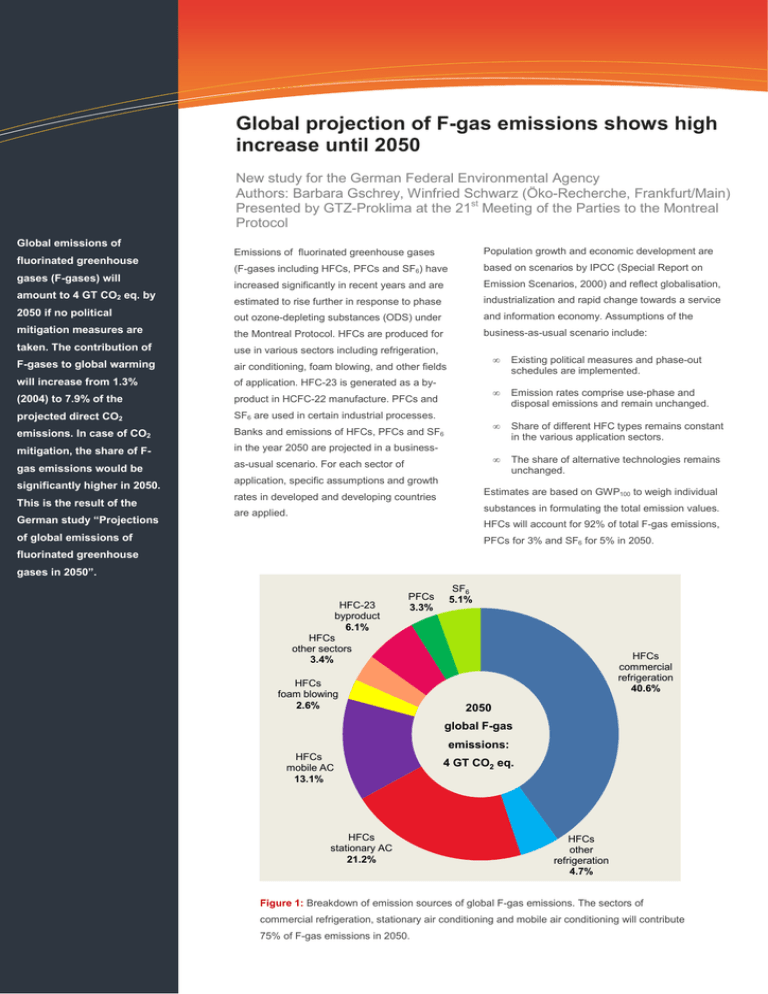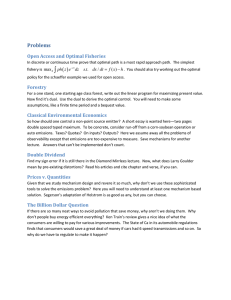2050 - Umweltbundesamt
advertisement

The sectors of commercial refrigeration, stationary air conditioning and mobile air conditioning will contribute 75% of F-gas emissions in 2050. InformationstechnologieLösungen Global projection of F-gas emissions shows high increase until 2050 New study for the German Federal Environmental Agency Authors: Barbara Gschrey, Winfried Schwarz (Öko-Recherche, Frankfurt/Main) Presented by GTZ-Proklima at the 21st Meeting of the Parties to the Montreal Protocol Global emissions of fluorinated greenhouse gases (F-gases) will amount to 4 GT CO2 eq. by 2050 if no political Emissions of fluorinated greenhouse gases Population growth and economic development are (F-gases including HFCs, PFCs and SF6) have based on scenarios by IPCC (Special Report on increased significantly in recent years and are Emission Scenarios, 2000) and reflect globalisation, estimated to rise further in response to phase industrialization and rapid change towards a service out ozone-depleting substances (ODS) under and information economy. Assumptions of the mitigation measures are the Montreal Protocol. HFCs are produced for business-as-usual scenario include: taken. The contribution of use in various sectors including refrigeration, F-gases to global warming air conditioning, foam blowing, and other fields will increase from 1.3% of application. HFC-23 is generated as a by- (2004) to 7.9% of the product in HCFC-22 manufacture. PFCs and projected direct CO2 SF6 are used in certain industrial processes. emissions. In case of CO2 Banks and emissions of HFCs, PFCs and SF6 mitigation, the share of F- in the year 2050 are projected in a business- gas emissions would be as-usual scenario. For each sector of significantly higher in 2050. This is the result of the German study “Projections • Existing political measures and phase-out schedules are implemented. • Emission rates comprise use-phase and disposal emissions and remain unchanged. • Share of different HFC types remains constant in the various application sectors. • The share of alternative technologies remains unchanged. application, specific assumptions and growth Estimates are based on GWP100 to weigh individual rates in developed and developing countries substances in formulating the total emission values. are applied. HFCs will account for 92% of total F-gas emissions, of global emissions of PFCs for 3% and SF6 for 5% in 2050. fluorinated greenhouse gases in 2050”. HFC-23 byproduct 6.1% HFCs other sectors 3.4% PFCs 3.3% HFCs foam blowing 2.6% SF6 5.1% HFCs commercial refrigeration 40.6% 2050 global F-gas emissions: HFCs mobile AC 13.1% HFCs stationary AC 21.2% 4 GT CO2 eq. HFCs other refrigeration 4.7% Figure 1: Breakdown of emission sources of global F-gas emissions. The sectors of commercial refrigeration, stationary air conditioning and mobile air conditioning will contribute 75% of F-gas emissions in 2050. Figure 2: The steep rise in F-gas emissions until 2050 is primarily caused by the expansion of the refrigeration and air conditioning sector, especially the commercial refrigeration sector. Global F-gas emissions in 2050 are In comparison to earlier projections of future HFC projected to contribute ca. 7.9% of projected emissions (e.g. Velders et al. 2009), the following global CO2 emissions in business-as-usual differences should be noted: scenarios (combined scenario A1B and B1 from Special Report on Emission Scenarios, Sector-specific growth rates for developed and 2000). In 2004, the share of F-gas developing countries were used for the projections emissions amounted to 1.3% only. of F-gas emissions by sector. For some sectors, projections of HFC banks and Emissions from developing countries will emissions in 2020 by UNEP TEAP (2009) were exceed emissions from developed countries used as baseline. in most sectors. In the business-as-usual Contact scenario outlined, developing countries will Long-term growth rates incorporate not-in-kind account for 75% of total emissions of alternatives to ODS and market saturation for fluorinated greenhouse gases in 2050. various products containing HFCs. Thus, long-term They hence play a key role in measures to growth rates are lower than short-term rates. reduce F-gas emissions. Per capita Öko-Recherche emissions will range at 0.42 t in developing This study, just as other studies, underlines the Barbara Gschrey countries and 0.68 t in developed countries urgent need for mitigation measures of F-gas barbara.gschrey@proklima.net (global average: 0.46 t per capita). emissions. Winfried Schwarz ws@oekorecherche.de German Federal Environmental Agency Cornelia Elsner cornelia.elsner@uba.de The study is available online at http://www.umweltbundesamt.de/produkte-e/index.htm.



